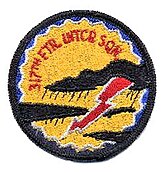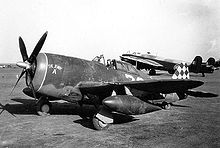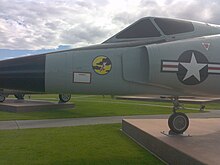| 317th Fighter Interceptor Squadron | |
|---|---|
 317th Fighter-Interceptor Squadron F-102 Delta Dagger 317th Fighter-Interceptor Squadron F-102 Delta Dagger | |
| Active | 1942–1945; 1947–1969 |
| Country | |
| Branch | |
| Role | Interceptor |
| Part of | Aerospace Defense Command |
| Motto(s) | ' |
| Engagements | Mediterranean Theater of Operations |
| Decorations | Distinguished Unit Citation Air Force Outstanding Unit Award |
| Insignia | |
| Patch with the 317th Fighter-Interceptor Squadron emblem |  |
| 317th Fighter Squadron emblem |  |
The 317th Fighter Interceptor Squadron is an inactive United States Air Force unit, last assigned to Aerospace Defense Command, at Elmendorf Air Force Base, Alaska, where it was inactivated on 31 December 1969.
The squadron was first activated as the 317th Fighter Squadron during World War II. After training in the United States, it deployed to North Africa. In combat operations in the Mediterranean Theater of Operations. It was withdrawn from combat from September to December 1943 while it equipped with different aircraft and moved from Africa to Italy. It earned two Distinguished Unit Citations before returning to the United States for inactivation.
The squadron returned to service as an air defense unit in 1947, serving in that role until inactivated in 1969.
History
World War II
The squadron was first organized at Mitchel Field, New York on 3 August 1942 as one of the three original squadrons of the 325th Fighter Group, but moved the same day to Hillsgrove Army Air Field, Rhode Island. It equipped with Curtiss P-40 Warhawks and trained for combat at Hillsgrove until late January 1943, when it began to deploy overseas.

The squadron arrived in the Mediterranean Theater of Operations in February and was established at its first combat station, Tafaraoui Airfield, Algeria by 28 February 1943. It flew its first combat mission on 17 April. It escorted medium bombers. It flew strafing missions and flew sweeps over the Mediterranean Sea from bases in Algeria and Tunisia. The squadron participated in the defeat of Axis forces in Tunisia. It participated in the reduction of Pantelleria and in Operation Husky, the invasion and conquest of Sicily. On 30 July, the 325th Group used diversionary tactics to lure a superior number of enemy planes into the air over Sardinia, destroying more than half of them. The squadron was awarded its first Distinguished Unit Citation for this action. In late September 1943, the squadron was withdrawn from combat to convert to Republic P-47 Thunderbolts and prepare to move to the Italian peninsula.

By early December 1943, the squadron began to operate its Thunderbolts from Foggia Airfield, Italy, flying its first mission with the new plane on 14 December. However, it only operated the P-47 for a short period, converting to North American P-51 Mustangs in March 1944, and moving to Lesina Airfield, Italy on the 29th of the month. However, on 30 January it flew its "T-Bolts" more than 300 miles at very low altitude to make a surprise attack on German interceptors defending airdromes near Villorba. The severe losses it inflicted on the defending forces enabled heavy bombers to attack vital targets in the area without encountering serious opposition. This action resulted in the second award of the Distinguished Unit Citation to the squadron.

It escorted the heavy bombers of Fifteenth Air Force on long range missions against the Daimler Benz factory in Berlin, the Messerschmitt factory in Regensburg and oil refineries near Vienna. It also flew escort for attacks on other targets, such as airfields and marshalling yards and lines of communication in Italy, France, Germany, Czechoslovakia, Austria, Hungary, Yugoslavia and Romania. It also protected reconnaissance aircraft and strafed trains, vehicles and airfields. The squadron continued operations until May 1945. The 317th was credited with the destruction of 209 enemy aircraft in air to air combat. After V-E Day, it moved to Vincenzo Airfield, Italy, remaining there until October, when it returned to the United States and was inactivated at Camp Kilmer, New Jersey on 28 October.
Air Defense Command

In May 1947, the squadron was reactivated at Mitchel Field, New York and equipped with Northrop P-61 Black Widows. it moved to Moses Lake Air Force Base, Washington, the squadron was re-equipped with the new North American F-82 Twin Mustang in October 1948. The squadron was assigned for the defense of the Hanford Nuclear Reservation in Eastern Washington. One month later it was reassigned to Hamilton Air Force Base, California, and in April 1950, returned to McChord Air Force Base, Washington.

In 1951. the squadron was redesignated as the 317th Fighter Interceptor Squadron, a component of the 25th Air Division, Air Defense Command, During the period between 1947 and 1956. the 317th flew the F-82. the Lockheed F-94 Starfire, and the North American F-86D Sabre interceptor. In 1955 and 1956, at Vincent Air Force Base, Yuma, Arizona, flying the F-86D, the 317th engaged in airborne rocket competition, breaking all records previously set. In August 1956 the squadron was selected as the best air defense unit in the Air Force and was awarded the Hughes Trophy, In addition, the squadron received its first Outstanding Unit Award for high combat readiness for the period of 1953 through 1956. In November 1956, the 317th began transitioning into the Convair F-102 Delta Dagger.
Alaskan Air Command

In November 1956, the 317th began transitioning into the F-102A Delta Dagger, becoming the second squadron to receive the new delta-winged supersonic aircraft. In August 1957, the 317th was reassigned in force, to Elmendorf Air Force Base, Alaska, where it assumed air defense mission of the southern portion of Alaska and the northwestern approaches to the United States.
In the summer of 1960. the 449th Fighter-Interceptor Squadron was inactivated and Ladd Air Force Base was closed. leaving the entire Alaska air defense mission to the 317th. To carry out this mission, the squadron was authorized 40 aircraft and 60 pilots. The squadron received its second Air Force Outstanding Unit Award for maintaining full combat readiness during and after the 1964 Alaska earthquake on 27 March 1964.
In the summer of 1965, the 317th was reduced to 29 aircraft and the manning reduced accordingly, but the air defense mission remained the same. In October 1965, the squadron was awarded the Hughes Trophy for the second time, and a third Air Force Outstanding Unit Award for combat readiness.
In December 1969, due to budget reductions, the 317th Fighter-Interceptor Squadron was inactivated.
Lineage
- Constituted as the 317th Fighter Squadron on 24 June 1942
- Activated on 3 August 1942.
- Inactivated on 28 October 1945
- Activated on 25 August 1947
- Redesignated 317th Fighter Squadron (All Weather)' on 10 May 1948
- Redesignated 317th Fighter-All Weather Squadron on 20 January 1950
- Redesignated 317th Fighter-Interceptor Squadron on 1 May 1951
- Inactivated on 31 December 1969
Assignments
|
|
Stations
|
|
Aircraft
|
|
Awards and campaigns
| Award streamer | Award | Dates | Notes |
|---|---|---|---|
| Presidential Unit Citation | 30 July 1943 | Sardinia, 317th Fighter Squadron | |
| Presidential Unit Citation | 30 January 1944 | Italy, 317th Fighter Squadron | |
| Air Force Outstanding Unit Award | 1 March 1953-30 June 1956 | 317th Fighter-Interceptor Squadron | |
| Air Force Outstanding Unit Award | 27 March 1964–30 April 1964 | 317th Fighter-Interceptor Squadron | |
| Air Force Outstanding Unit Award | 1 July 1964–30 Jun 1965 | 317th Fighter-Interceptor Squadron | |
| Air Force Outstanding Unit Award | 1 July 1965–30 Jun 1966 | 317th Fighter-Interceptor Squadron | |
| Air Force Outstanding Unit Award | 8 July 1966–1 May 1967 | 317th Fighter-Interceptor Squadron | |
| Air Force Outstanding Unit Award | 2 May 1967–1 January 1968 | 317th Fighter-Interceptor Squadron | |
| Air Force Outstanding Unit Award | 2 January 1968–31 December 1968 | 317th Fighter-Interceptor Squadron | |
| Air Force Outstanding Unit Award | 1 January 1969–31 December 1969 | 317th Fighter-Interceptor Squadron |
See also
References
- Notes
- Aircraft is Convair F-102A-70-CO Delta Dagger serial 56-1259
- Approved 13 December 1951.
- Aircraft is North American P-82F Twin Mustang serial 46-415 at Hamilton AFB, California in 1948.
- Aircraft is Lockheed F-94A-5-LO serial 49-2577, taken in 1951. The 317th FIS was the first squadron with the F-94A Starfire.
- Citations
- ^ Maurer, Combat Squadrons, pp. 386–387
- Watkins, p. 45
- ^ Maurer, Combat Units, pp. 206-208
- Newton & Senning, pp. 594-596
- ^ Lineage, including assignments and stations, through 1963 in Maurer, Combat Squadrons, pp. 386–387
- Cornett & Johnson, p. 124
- ^ AF Pamphlet 900-2, Vol, 1, p. 312
- AF Pamphlet 900-2, Vol, 2, p. 58
Bibliography
![]() This article incorporates public domain material from the Air Force Historical Research Agency
This article incorporates public domain material from the Air Force Historical Research Agency
- Cornett, Lloyd H; Johnson, Mildred W (1980). A Handbook of Aerospace Defense Organization, 1946–1980 (PDF). Peterson AFB, CO: Office of History, Aerospace Defense Center. Archived from the original (PDF) on 13 February 2016. Retrieved 23 March 2012.
- Maurer, Maurer, ed. (1983) . Air Force Combat Units of World War II (PDF) (reprint ed.). Washington, DC: Office of Air Force History. ISBN 0-912799-02-1. LCCN 61060979. Retrieved 17 December 2016.
- Maurer, Maurer, ed. (1982) . Combat Squadrons of the Air Force, World War II (PDF) (reprint ed.). Washington, DC: Office of Air Force History. ISBN 0-405-12194-6. LCCN 70605402. OCLC 72556. Retrieved 17 December 2016.
- Newton, Wesely P. Jr.; Senning, Calvin F. (1963). "USAF Credits for the Destruction of Enemy Aircraft, World War II, USAF Historical Study No. 85" (PDF). Research Studies Institute, USAF Historical Division, Air University. Retrieved 27 July 2022.
- Pape, Garry R.; Campbell, John M.; Campbell, Donna (1991). Northrop P-61 Black Widow: The Complete History and Combat Record. Minneapolis, MN: Motorbooks International. ISBN 978-0-879385-09-5.
- Watkins, Robert A. (2009). Insignia and Aircraft Markings of the U.S. Army Air Force In World War II. Vol. IV, European-African-Middle Eastern Theater of Operations. Atglen,PA: Shiffer Publishing, Ltd. ISBN 978-0-7643-3401-6.
- "AF Pamphlet 900-2, Unit Decorations, Awards and Campaign Participation Credits" (PDF). Washington, DC: Department of the Air Force Index. 15 June 1971. Archived from the original (PDF) on 4 August 2015. Retrieved 11 August 2016.
- "AF Pamphlet 900-2, Unit Decorations, Awards and Campaign Participation Credits, Vol II" (PDF). Washington, DC: Department of the Air Force. 30 September 1976. Archived from the original (PDF) on 4 August 2015. Retrieved 11 August 2016.
- "ADCOM's Fighter Interceptor Squadrons". The Interceptor. 21 (1). Aerospace Defense Command: 5–11, 26–31, 40–45, 54–59. January 1979.
| |||||||||||||||||||||
| |||||||||||||||||||||
| |||||||||||||||||||||
